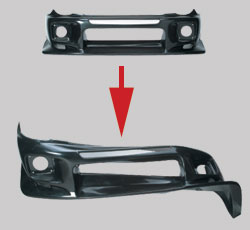 |
 |
 |
Pliable Fiber Reinforced Plastic:
This material has similar properties to those of FRP, but is a lot
more flexible. The front bumper and Front Half Spoilers made with
PFRP are much more difficult to crack due to its flexibility. Side
skirts and rear under fins are much more pliable when installing.
Depending upon the paint, PFRP aero-parts are much easier to repair,
even with damage received while the vehicle is in motion. |
 |
Fiber Reinforced Plastic:
This material is reinforced by the glass fibers in the polyester resin
which strengthens fiber reinforced plastic products. A great property
of this material is that you can form any size or shape while still
retaining a large degree of strength. Due to these characteristics,
FRP is widely used by most aero-parts manufacturers. |
 |
Carbon Fiber Reinforced Plastic:
Generally FRP is reinforced using only glass fibers. Carbon fiber
derives its strength and lightness by replacing these glass fibers
with carbon fibers in the resin. |
 |
Polyester Carbon Composite:
C-West uses PCC for almost all of its Carbon Fiber products. The polyester
resin is the same as that of FRP, but instead of glass fibers, Carbon
Fibers are used to reinforce the product. Unlike FRP, the Carbon fibers
in PCC are layered on top of each other, which is what makes PCC extremely
strong and durable. |
 |
Press Polyester Carbon Composite:
PPCC is basically the same material as PCC, but PPCC will provide
better rigidity than PCC when creating complex shapes. This new method
is used when producing much more complicated shapes that were originally
almost impossible for others to create. |
 |
Dry Carbon Composite:
The literal name of this material is ECC (Epoxy Carbon Composite),
but generally it is known as Dry Carbon. Dry Carbon is a plastic reinforced
with an epoxy resin containing Carbon Fiber. Vacuum bag processing
is used to apply heavy pressure, and then extreme heat is applied
to harden the product, creating an amazingly strong and lightweight
material. |
 |
Carbon Honeycomb Composite:
When creating products using this material, we insert a sheet consisting
of numerous thin honeycomb shapes, between two thin sheets of carbon
fiber, creating the strongest, and lightest of all carbon composites.
This method is often applied to the chassis of Formula-1 cars where
the strongest and most lightweight materials are needed. |
 |
Polyurethane Resin:
Urethane Resin is known as a common material in the mass-production
of aero-parts. The method used for manufacturing polyurethane differs
completely from the method used to manufacture FRP. When manufacturing
polyurethane aero-parts, two liquid resins are mixed together, and
a press is used to harden the material. There are varying degrees
of strength when referring to polyurethane, and the type used to manufacture
aero-parts is similar in strength to polypropylene, and is known to
be very flexible, and hard to crack. |
 |
Aluminum:
Aluminum can reduce 40% of weight when compared with products made
of copper and iron, and 1/3 of weight when compared with Titanium.
It is useful for reducing weight, and saving energy. Aluminum is used
for producing a multitude of products because it is very easy to manufacture.
There is an abundance of methods used in the processing of aluminum,
from general processing to special processing. Other than its lightweight
properties, aluminum is used for many different things because it
is strong, and very resistant to corrosion. |






